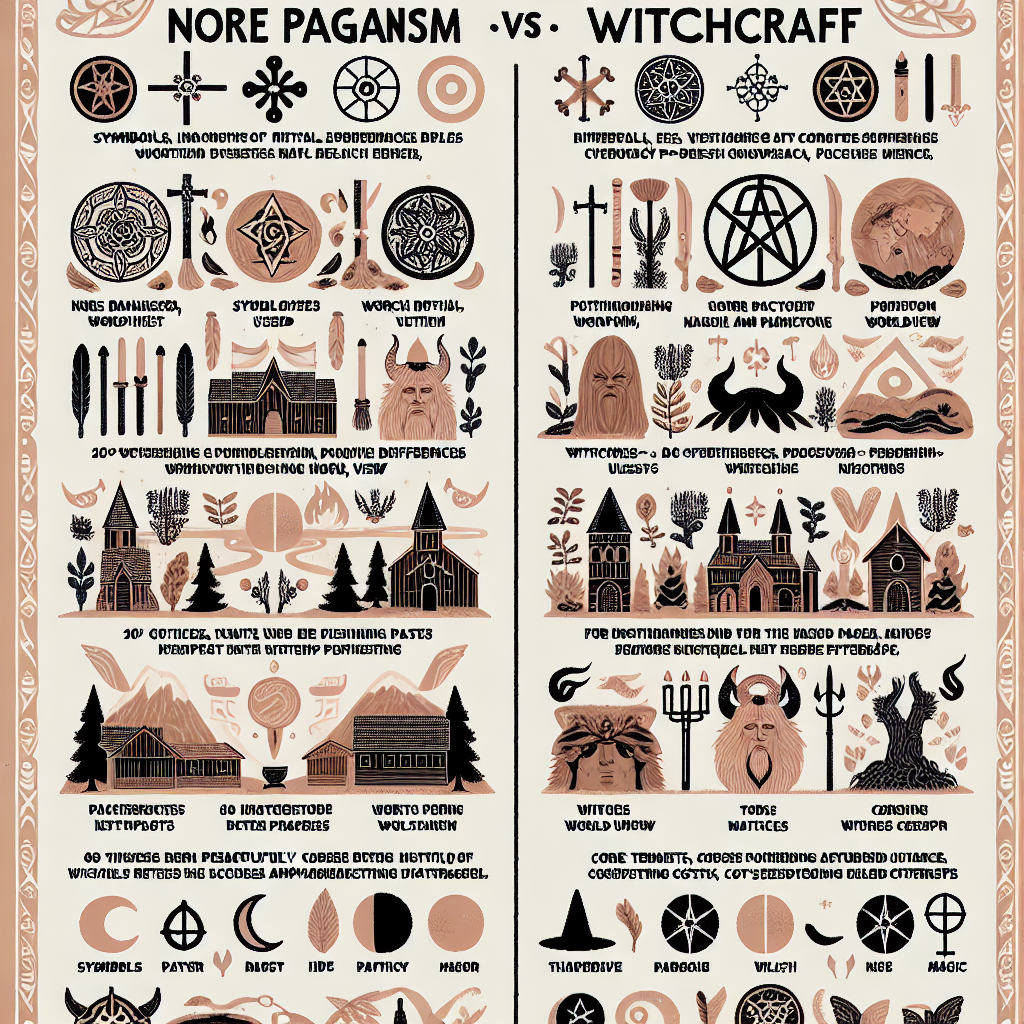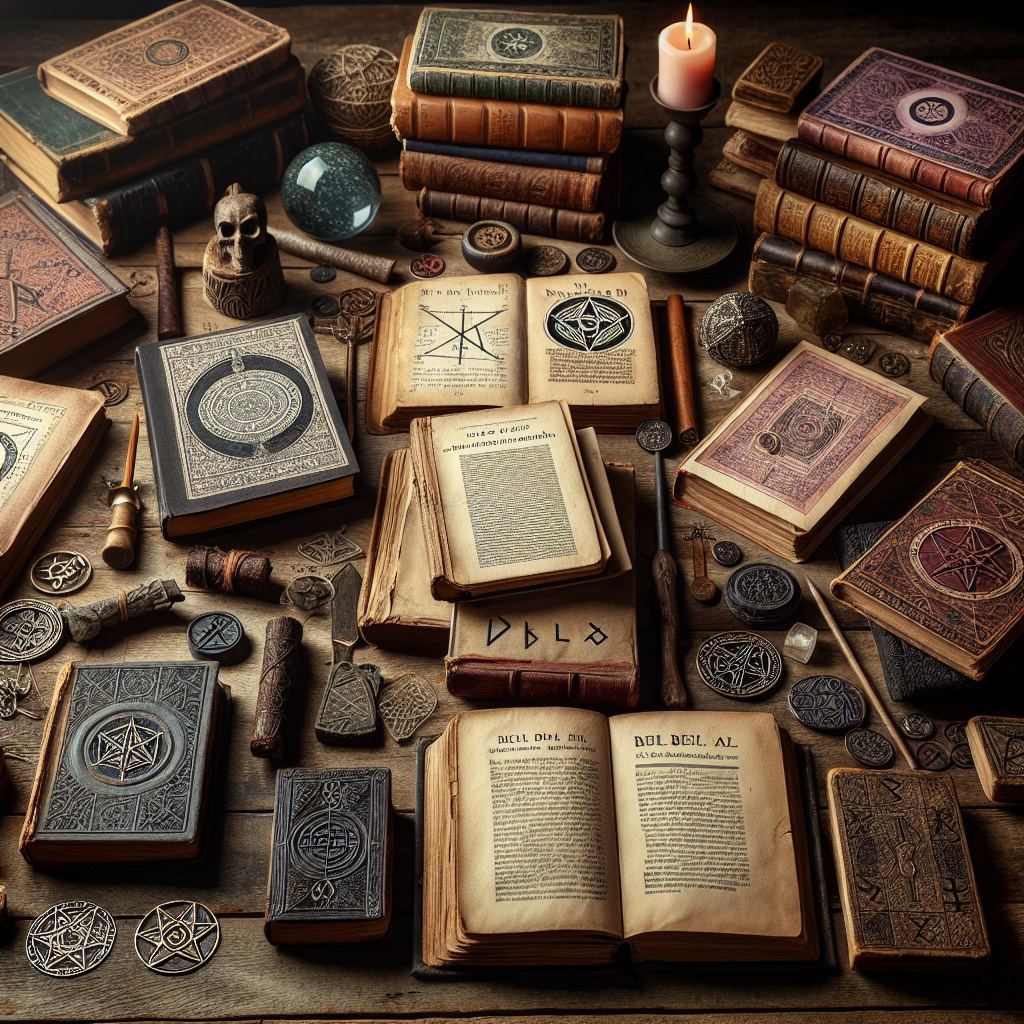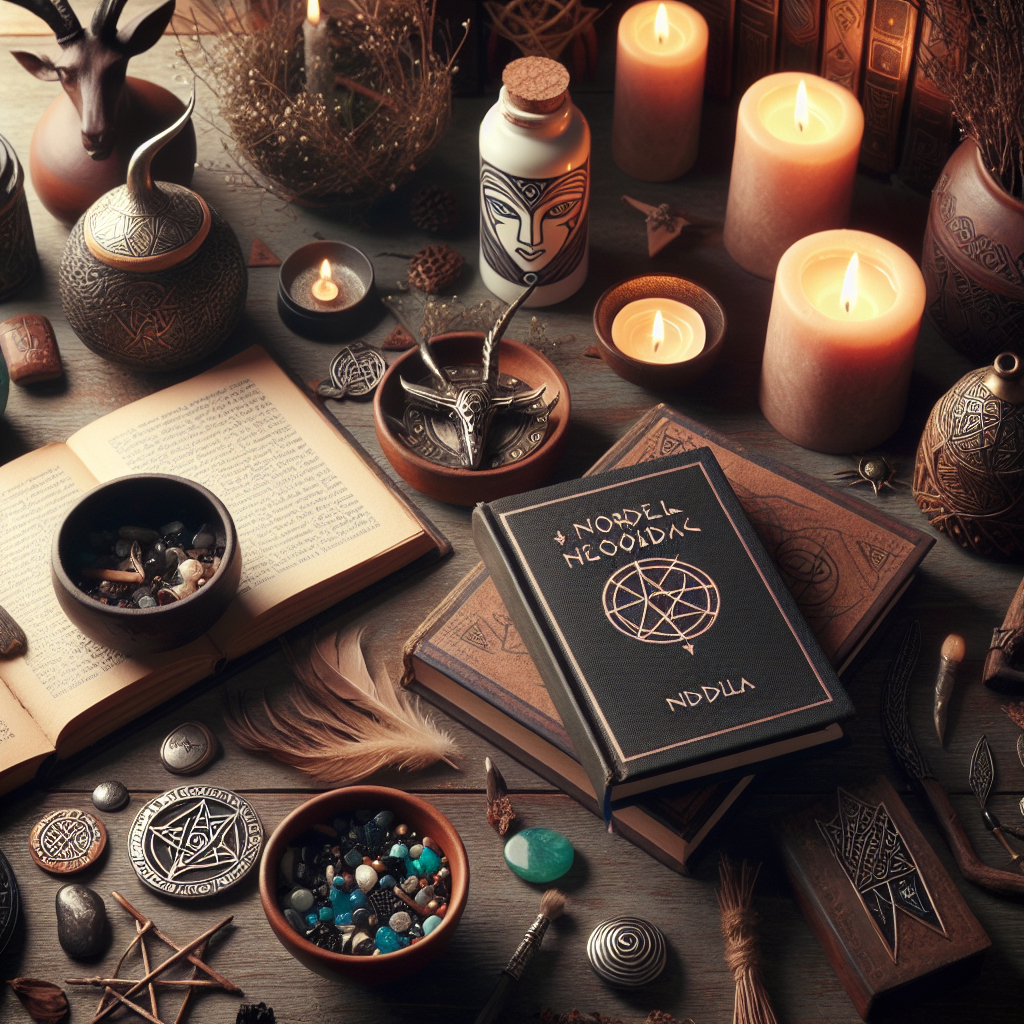As an Amazon Associate I earn from qualifying purchases.

Norse Paganism, also known as Heathenry or Old Norse Religion, and Witchcraft may seem similar due to their connections to ancient traditions and nature. However, they have various distinct differences.
In Norse Paganism, there is a strong focus on the gods and goddesses of the Norse pantheon, such as Odin, Thor, and Freyja. This contrasts with Witchcraft, where practitioners might not adhere to any specific pantheon and often incorporate diverse deities from different traditions.
Systems of Belief and Worship
Norse Pagans engage in practices such as blot, a sacrificial ritual to honor their gods, compared to Wiccans who perform Sabbats and Esbats based on lunar and solar cycles. Ritual structures and purposes thus vary considerably between the two.
In terms of sacred texts, Norse Paganism heavily relies on the Eddas and Sagas, ancient writings that capture their myths, poems, and religious practices. Witchcraft lacks a single unifying text and instead draws upon a variety of grimoires, historical texts, and contemporary writings.
Holy Days and Festivals
Festivals play a crucial role in both traditions. Norse Paganism celebrates holidays like Yule, Ostara, and Midsummer, while Witchcraft observes the Wheel of the Year, consisting of eight Sabbats that mark seasonal changes.
The practice of divination differs as well. Norse Pagans might use runes, stones inscribed with alphabetic symbols from the Runic alphabet, whereas witches might use tools like tarot cards, scrying bowls, or pendulums.
Magic and Spellcasting
Magic is another area of contrast. Seiðr is the form of magic linked with Norse Paganism involving trance work and sometimes shamanic practices, while Witchcraft employs a wider range of magical practices and spell work, depending on the various traditions within it.
Notable differences are seen in the source of magical power. Norse Pagans often invoke their gods for energy and blessings, in contrast to witches who may draw upon natural elements, personal energy, or the divine as they perceive it.
Community and Organizational Structures
Communal aspects also vary, with Norse Paganism often emphasizing the importance of kindreds or hearths — small, family-like groups — for rituals and community life. Witchcraft can be more solitary, though covens — groups usually consisting of 13 members — are also prevalent for performing rituals and practices.
Witchcraft has experienced a dramatic resurgence in the recent past, evidenced by the rapid rise in its practitioners. According to surveys, Witchcraft’s popularity has surged by nearly 2,300% in the United States over the past few decades.
Ethical Systems and Worldviews
Ethically, Norse Paganism often focuses on a set of values known as the Nine Noble Virtues, with an emphasis on honor, courage, and loyalty. In contrast, Witchcraft practices such as Wicca adhere to the Wiccan Rede, which states “An it harm none, do what ye will.
Individuality within belief systems is another important aspect. Norse Paganism often emphasizes a communal identity reflective of historical tribes, contrasting with Witchcraft, where individual paths and personal spiritual growth are more stressed.
Both traditions emphasize a deep appreciation for nature, but in Norse Paganism, this is found in the veneration of land spirits and ancient places. Witchcraft, conversely, incorporates ecology into its magical framework, often integrating modern environmental practices into its spirituality.
Here are 20 key differences between Norse Paganism and Witchcraft, shedding light on their unique practices, beliefs, and traditions:
1. **Deities and Pantheon:**
Norse Paganism is centered around the worship of Norse gods such as Odin, Thor, and Freyja, whereas Witchcraft does not adhere to a particular pantheon. Practitioners of Witchcraft may honor a diverse array of deities from various cultures or none at all.
2. **Historical Roots:**
Norse Paganism originated in Scandinavia during the Viking Age with a rich history tied to Norse mythology and sagas. Witchcraft, in contrast, has a more eclectic origin, drawing from numerous ancient practices across different cultures and time periods.
3. **Core Beliefs:**
The belief system in Norse Paganism revolves around the cosmology of Yggdrasil, the World Tree, and nine worlds, governed by the laws of Wyrd (fate). Witchcraft generally emphasizes personal empowerment and the manipulation of natural forces through spells and rituals.
4. **Sacred Texts:**
Key Norse pagan books include the Poetic Edda and the Prose Edda, which provide foundational myths and legends. Witchcraft readings may reference texts like the “Book of Shadows,” “The Witches' Bible,” and works by contemporary authors exploring magical practices and rituals.
5. **Ritual Practices:**
Norse Pagans often reconstruct ancient ceremonies, like blóts and sumbels, to honor their gods. Witchcraft rituals are more varied, including spell-casting, Sabbats, and Esbats, tailored to the practitioner's tradition or personal beliefs.
6. **Symbols and Tools:**
Symbols like Mjölnir (Thor's hammer) and the Valknut are significant in Norse Paganism. Witchcraft employs a wide range of symbols and tools, such as pentacles, athames (ritual knives), and cauldrons, depending on the particular tradition practiced.
7. **Afterlife Beliefs:**
Norse Paganism has a specific view of the afterlife, including realms like Valhalla and Hel. Witchcraft views on the afterlife are diverse, ranging from reincarnation to spiritual realms, reflecting the personal and eclectic nature of the practice.
8. **Community and Structure:**
Norse Paganism can involve group rituals and activities organized by kindreds or hearths. Witchcraft is often practiced alone or in covens, with a less hierarchical structure and more emphasis on solitary practice.
9. **Seasonal Observances:**
Both traditions observe seasonal festivals, but they differ in specifics. Norse Paganism celebrates festivals like Yule, Ostara, and Midsummer based on ancient Nordic calendars. Witchcraft observes the Wheel of the Year, including Sabbats like Samhain, Imbolc, and Litha.
10. **Magic Practices:**
Norse Pagan practices include seidhr (a form of sorcery) and rune magic. Witchcraft's magical practices are broad and can include herbalism, divination, candle magic, and various forms of spell casting.
11. **Ancestral Veneration:**
Ancestral worship is a strong component of Norse Paganism, with a focus on honoring one's lineage and familial spirits. While some practitioners of Witchcraft venerate ancestors, it is not a universal practice across all traditions.
12. **Moral Codes:**
Norse Paganism emphasizes virtues such as honor, courage, and loyalty, often deriving these values from ancient sagas and the Hávamál. Witchcraft's ethical guidelines, like the Wiccan Rede (“An it harm none, do what ye will”), are more fluid and vary by tradition.
13. **Language and Lore:**
Old Norse language and specific mythological narratives are integral to Norse Pagan practices. Witchcraft does not require knowledge of a particular language or set mythos and typically incorporates a wider range of cultural elements.
14. **Spiritual Leaders:**
In Norse Paganism, spiritual guidance can come from gothar (priests) or volvas (seers). Witchcraft may have high priests/priestesses within covens, but individual guidance often comes from personal study and mentorship.
15. **Divination Methods:**
Runes are commonly used in Norse Paganism for divination purposes. Witchcraft employs various divination tools, including Tarot cards, scrying mirrors, and pendulums, each with its unique method and symbolism.
16. **Healing Practices:**
Norse Pagan healing methods often involve runic healing and traditional Nordic herbalism. Witchcraft incorporates a wider spectrum of healing practices, including energy healing, crystal work, and holistic herbology.
17. **Sacred Spaces:**
Norse Pagans may create ve (sacred enclosures) or use natural landscapes for their rituals. In Witchcraft, sacred spaces are often defined by the creation of a magic circle for ritual work and can be setup anywhere.
18. **Cultural Influence:**
Norse Paganism is heavily influenced by its Scandinavian origins and often integrates historical reenactments. Witchcraft, particularly Wicca, has been shaped by European folk traditions but remains more adaptable and globally influenced.
19. **Educational Resources:**
Essential texts for those studying Norse Paganism include works by Snorri Sturluson and Norse sagas, while Witchcraft readings might involve books by authors like Gerald Gardner, Scott Cunningham, and Doreen Valiente, reflecting the tradition's evolution.
20. **Statistical Growth:**
According to a study, the number of people identifying with Norse Paganism has increased significantly, while contemporary Witchcraft has seen a resurgence in public interest, with millions of practitioners around the world.
This comparative examination demonstrates that while both traditions share a connection to ancient spiritual teachings and shared knowledge, the specifics of their practices, beliefs, and cultural contexts differentiate them distinctly.
1. Connection to Deities
When I first stepped into the realm of Norse Paganism, the bond I felt with the gods like Odin, Thor, and Freyja was intensely personal. Rituals and offerings revolved around honoring these ancient deities, and I felt a deep spiritual presence when engaging in these rituals.
In contrast, my experience with practicing Witchcraft often felt more eclectic. While there were elemental spirits and nature-based deities involved, it wasn't tied to a specific pantheon. The approach was more individualistic, allowing for a mix of influences from different traditions.
This distinction became especially evident during group rituals. Norse Pagan gatherings would often have a communal focus on specific gods from the Norse pantheon, whereas Witchcraft circles were more flexible, sometimes incorporating deities from multiple pantheons or none at all.
2. Ritual Practices
Norse Paganism often entailed elaborate, communal rituals called blóts. These ceremonies were structured and steeped in historical tradition. I found myself fully immersed in the ancient practices, which often included sacrifices, mead offerings, and communal feasting.
On the other hand, Witchcraft rituals were more solitary and less formal in my experience. I cherished the freedom to design rituals based on my personal needs, sometimes following the Wheel of the Year or simply casting spells during a full moon. The tools and ingredients were usually chosen for their symbolic significance rather than tradition.
This divergence in ritual structure became most apparent during seasonal celebrations. Norse Pagan festivities like Yule had specific customs steeped in centuries of tradition, whereas my Witchcraft celebrations allowed for personalized interpretations of Sabbats such as Samhain or Ostara.
3. Cosmological Views
The Nine Worlds of Norse cosmology and the World Tree, Yggdrasil, formed the backbone of my understanding of the universe in Norse Paganism. Every ritual and meditation was influenced by this intricate worldview, giving me a comprehensive structure to explore spirituality.
In contrast, Witchcraft’s cosmology felt more fluid and adaptable. There wasn't a single, dominant structure to adhere to, which allowed me to draw from various belief systems. The focus was often on the harmony between elements, lunar phases, and natural cycles rather than a fixed cosmological model.
This distinction became clear during meditative practices. Meditating in the context of the Nine Worlds brought a sense of connectedness to a specific tradition in Norse Paganism, while meditations in Witchcraft were more improvisational and guided by immediate spiritual needs.
4. Use of Magic and Spells
In Norse Paganism, magic often took the form of runes and seidr. My journey with runes was a deep dive into the mysteries of these ancient symbols. Casting runes or using them in talismans felt like tapping into the very fabric of Norse heritage, providing me with profound spiritual insights.
Witchcraft's magic, however, was more diverse and varied. Spellwork could include anything from candle magic to herbal alchemy. This versatility allowed me to tailor my magical practice to my specific goals, invoking different methods and correspondences as needed.
One of the most striking contrasts I noticed was in the intention-setting process. In Norse Paganism, spells and magical practices frequently paid homage to the gods, asking for their guidance and blessing. In Witchcraft, the focus was often more autonomous, empowering the individual to manifest their own desires and intentions through careful planning and magical correspondences.
u003cH2u003e1. What are some key differences between Norse Paganism and Witchcraft?u003c/H2u003e
u003cpu003eNorse Paganism is a polytheistic belief system centered around Norse gods and mythology, while Witchcraft is a practice that can include various forms of magic and may not necessarily involve worship of specific deities. Norse Paganism often involves specific rituals, feasts, and veneration of gods like Odin and Thor, whereas Witchcraft can be more eclectic and personalized.u003c/pu003e
u003cH2u003e2. Can you recommend essential books for understanding Norse Paganism?u003c/H2u003e
u003cpu003eSome essential texts for understanding Norse Paganism include the “Prose Edda” and “Poetic Edda,” both of which are primary sources of Norse mythology. Other valuable books include “The Norse Myths” by Kevin Crossley-Holland and “The Viking Spirit” by Daniel McCoy.u003c/pu003e
u003cH2u003e3. What are some fundamental texts for studying Witchcraft?u003c/H2u003e
u003cpu003eKey texts for studying Witchcraft may include “The Witch's Bible” by Janet and Stewart Farrar, “Wicca: A Guide for the Solitary Practitioner” by Scott Cunningham, and “The Spiral Dance” by Starhawk. These books offer various insights into the practices and beliefs within Witchcraft.u003c/pu003e
u003cH2u003e4. Are there any overlapping beliefs or practices between Norse Paganism and Witchcraft?u003c/H2u003e
u003cpu003eYes, there can be overlapping practices such as the use of runes for divination, nature worship, and ritualistic celebrations of the seasons like solstices and equinoxes. However, the underlying beliefs and deities worshiped can differ significantly.u003c/pu003e
u003cH2u003e5. How does one start practicing Norse Paganism?u003c/H2u003e
u003cpu003eTo start practicing Norse Paganism, one can begin by reading the foundational texts like the Eddas, learning about Norse deities, and understanding traditional rituals and feasts. Joining a community or group focused on Norse Paganism can also provide practical guidance and shared knowledge.u003c/pu003e
u003cH2u003e6. What are common practices in Witchcraft?u003c/H2u003e
u003cpu003eCommon practices in Witchcraft include spellcasting, ritual ceremonies, herbalism, and divination methods such as tarot reading or scrying. Many practitioners also emphasize personal empowerment and a deep connection with nature.u003c/pu003e
u003cH2u003e7. Is it possible to combine aspects of Norse Paganism and Witchcraft in one's spiritual practice?u003c/H2u003e
u003cpu003eYes, some individuals choose to blend aspects of both Norse Paganism and Witchcraft in their spiritual practices, creating a personalized path known as eclectic or syncretic practice. It’s important to approach both traditions with respect and understanding.u003c/pu003e
u003cH2u003e8. Are there any notable modern authors who write about Norse Paganism?u003c/H2u003e
u003cpu003eNotable modern authors who write about Norse Paganism include Diana L. Paxson, whose works cover various aspects of Norse mythology and practice, and Kveldulf Gundarsson, known for his detailed books on Asatru and Norse lore.u003c/pu003e
u003cH2u003e9. How crucial is historical authenticity in the practice of Norse Paganism?u003c/H2u003e
u003cpu003eHistorical authenticity varies among practitioners. Some emphasize reconstructing ancient practices as accurately as possible, known as Reconstructionism. Others adopt a more flexible approach, incorporating modern interpretations and practices.u003c/pu003e
u003cH2u003e10. What role do deities play in Witchcraft compared to Norse Paganism?u003c/H2u003e
u003cpu003eIn Witchcraft, deities can play a variable role depending on the practitioner’s path. Some may work with specific goddesses and gods, while others may focus on elemental or ancestral spirits. In Norse Paganism, the deities are central figures of worship and are deeply embedded in ritual and mythology.u003c/pu003e

## Conclusion
Norse Paganism and Witchcraft share a tapestry of rich traditions and profound teachings but diverge significantly in their foundational texts, spiritual views, and ritual practices. Norse Paganism is deeply rooted in the ancient texts of the Eddas and Sagas, which provide a historical and mythological framework for the worship of deities like Odin, Thor, and Freyja, and the reverence for nature and ancestral spirits. These texts serve as primary sources of spiritual guidance and ritual practice, emphasizing a connection to the Norse cosmology and the cyclical nature of time and existence. Conversely, Witchcraft, particularly modern Wicca, often draws upon the Book of Shadows and other contemporary works that synthesize a variety of folk magic traditions, seasonal rituals, and elemental reverence. The emphasis here is more on personal empowerment, the casting of spells, and the celebration of Sabbats like Beltane and Samhain.
Despite these differences, there are areas of convergence that highlight the shared human quest for spiritual meaning and connection to the metaphysical world. Both traditions value the importance of the natural world, the cycles of the moon and sun, and the intrinsic power of ritual and symbolism. They each possess a rich oral tradition that complements their written works, fostering communities through storytelling, shared practices, and mutual respect for the ancient wisdom passed down through generations. Ultimately, while Norse Paganism and Witchcraft are distinct paths with unique doctrines and practices, they reflect a broader spectrum of spiritual exploration that underscores the diversity and depth of human belief systems.
Amazon and the Amazon logo are trademarks of Amazon.com, Inc, or its affiliates.


